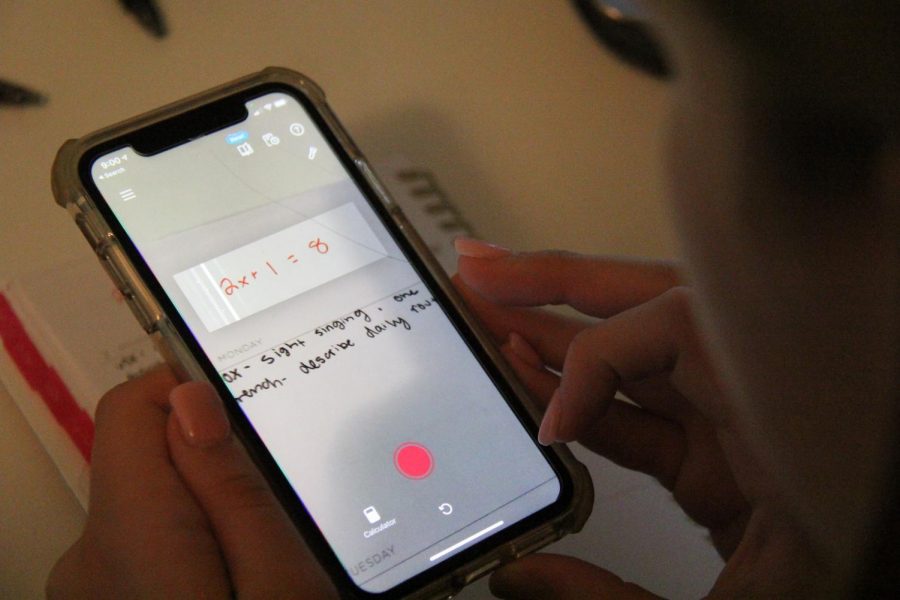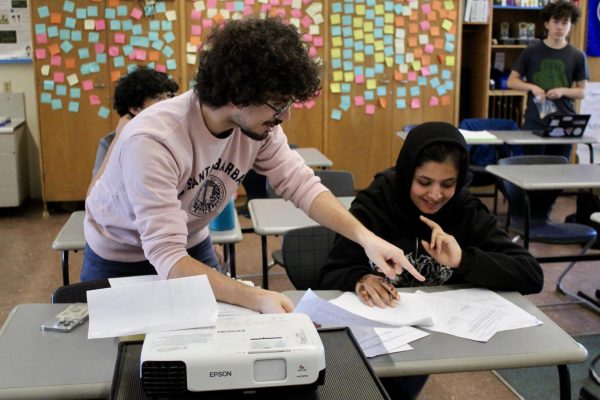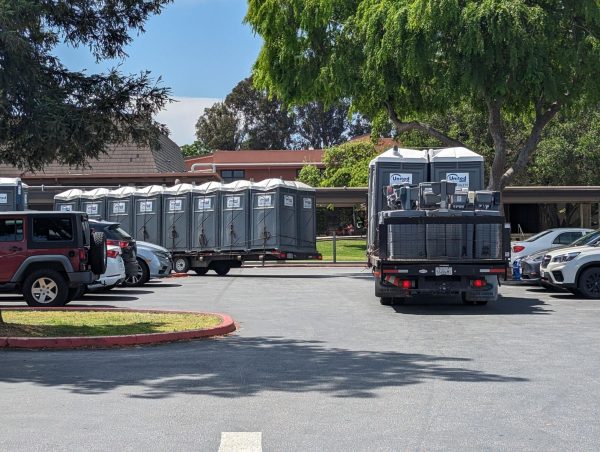Online learning brings new challenges regarding academic dishonesty
With the switch to online learning, the opportunity for academic dishonesty among classes has been widened. Apps such as Photomath have made using outside resources during tests and quizzes more accessible.
November 11, 2020
During remote learning, teachers and students have had to adapt alternate learning techniques. One area that has required extra thought by educators is how to control academic dishonesty. Officials at the University of Missouri discovered that students were creating group chats with others in the same course and using them during tests to take pictures of questions and share answers.
But that technique is not limited to universities. That practice has found its way into high school classrooms as well. And although the virtual learning situation arguably makes cheating harder to catch, if students are caught, cheating has the same consequences when it takes place in an online situation as it does if it had taken place in a classroom–including, in some cases, suspension.
Different departments are using different methods and strategies to try to prevent students from cheating on assessments. Freshman Evelyn Matusiak’s a math teacher with a unique method.
“Mrs. (Cheryl ) Zimmerman has us put our videos on in class. She also had us angle the camera to show our hands so she can see what we’re doing. Mrs. Zimmerman also has us participate in class by having us turn on our cameras. She calls on us and encourages us to answer problems and ask questions,” Matusiak said.
However, it is not just Zimmerman’s math class that is taking preventative measures to stop academic dishonesty. Some teachers are relying strongly on the honor system since they are without many other options.
Remote learning has made learning more difficult for students and has also required many teachers to begin putting extra thought into how to control academic dishonesty since traditional methods are no longer available. These various adapted methods tend to vary by department and by necessity.
Associate Principal Mike Franklin has witnessed these difficulties.
“It is very difficult for teachers to address, or even begin to address academic integrity,” Franklin said. “The kids just aren’t there. Something we got good at over the years was making sure our kids are doing the right things.”
World language teacher Caralyn Harmon, who teaches Spanish, understands that with remote learning there is just a lot that is out of her control.
“I feel like with remote learning I just don’t have enough control over stopping cheating. Unfortunately, I just have to be OK with knowing that students can cheat, and I try to make things more do-able. I reiterate that the work should be in their own words, and try to make them understand that it is okay to make mistakes,” Harmon said.
However, there are some very specific and district policies addressing the consequences of academic dishonesty.
The Rockwood School District student handbook outlines these guidelines: “First offense: Student/teacher conference, and/or administrative conference, instruction on academic honesty, parent contact, and possible consequences. Subsequent offenses: Office referral, parent contact, up to 10 days in-school suspension and possible consequences.”
To help prevent students from having to face these, teachers in different departments are starting to develop new techniques. Franklin has been supportive of these techniques and thinks that they have helped keep the rate of academic dishonesty low.
“I don’t know that we’ve seen much change really. I think that the conversations that teachers are having with kids are working and they’re being honest about not doing it.”
Social Studies Department moves to more response-based questions to assess students
The Social Studies Department is also coming up with strategies to prevent academic dishonesty. Teachers acknowledge that students might be more likely to cheat with remote learning and are beginning to adapt their assessments based on that. Social Studies teacher Amy Merriott is using many different methods for her different classes to lower the chances of academic dishonesty.
“There are definitely more opportunities to cheat, but students are being assessed in multiple ways,” Merriott said. “There are time limits on Canvas or on Advanced Placement (AP) Classroom for AP World History. For United States History I’ve added more written response assessments that allow students to offer their opinions on historical movements.”
Often students resort to cheating because they see the short-term beneficial effects. However, junior Katie Dobson looks rather at academic dishonesty as a whole and how it can affect a student’s academic performance on tests later in the year.
“You’re going to have to use that information, whatever was on the test, which you’ll most likely be tested on. Whether that’s on a final, or in AP classes on the AP exam, it’ll be more helpful if you take the test using your own knowledge to see where you’re at. That way you know how much you’ve actually learned,” Dobson said.
Science classes focus on peer learning to emulate classroom setting
Some teachers in the Science Department believe students are less likely to cheat in an in-person learning space, which means they are revising their curriculum to make it more difficult to be something that students could cheat on. Science teacher Sarah Scerba is trying to help her students get the best possible learning opportunities out of less-than-ideal circumstances in a few different ways.
“We are assessing more thought-provoking application type questions and problem-solving skills. We use peer collaboration daily and we create a positive classroom culture,” Scerba said.
Students can especially feel the temptation to cheat in classes where they are struggling or having a difficult time learning the material from home. Sophomore Brendan Berger is enrolled in a chemistry class and is one of those students who admits has felt the temptation to cheat, but hasn’t given in and instead looks toward the future.
“Just think about the payoff. You feel so much better when you don’t cheat and you get a 100% on a test that you were so worried about. That means that you know all of the material and you didn’t have to use any other students or any other resources to do so. It makes you feel good,” Berger said.
Language arts utilizes tools provided by Rockwood to identify plagiarism
In the Language Arts Department, preventing academic dishonesty focuses more on plagiarism on writing assignments more than cheating on tests. While the district used to utilize a program called TurnItIn.com that was discontinued last year. However, all assignments submitted through Canvas are run through an anti-plagiarism program called UniCheck.
Language Arts teacher Paul Jaycox knows first-hand how that can help prevent students from getting away with academic dishonesty and keep the student from facing strict consequences.
“In the event that plagiarism is indicated with the software, depending on the severity of the case, students could face a reduction in grade, a referral to administration and then there is a possibility that they would face some sort of consequence because of that. There is usually some sort of meeting with myself, the administrator, the parents and the student,” Jaycox said.
Some Language Arts teachers are utilizing a featured through Canvas called Canvas Moderator. It allows teachers to look at what students do during the time that they are supposed to be taking the test. One teacher who utilizes this is Jenny Ingram.
“It gives me some insight into what questions students struggled with the most, what they thought was hardest. Then that allows me to hone into specific skills,” Ingram said.
This feature allows the teachers to see what areas students struggled with, along with when they leave the quiz. It gives the benefit of allowing teachers to help focus on specific areas of curriculum students struggled with, and could also allow a teacher to catch a student cheating by leaving the page.
While there are multiple very strong safeguards in place for language arts teachers through the Canvas program, the original prevention of that dishonesty falls to the students making those decisions.
One student with a great understanding of the honor system is senior Jayden Widanai.
“I think that there is a lot of trust that teachers are giving to students, especially in this online format we have,” Widanai said. “There really is a big honesty policy that they give their students because teachers aren’t stupid. They know that we can cheat and that it’s really up to us to decide whether or not to.”
Math teachers implement timed tests to reduce opportunity for students to look up answers
In a remote learning environment, it is difficult to prove a student is committing academic dishonesty in a class. Because of this, math teachers have looked for ways to try to limit ways for students to be able to potentially cheat on tests in their classes. Math teacher Seth Atkins has also taken safeguards to help prevent his students from cheating on the tests during remote learning.
“The biggest precaution I am taking is making my tests timed. If the test is a good length and time, it makes it a lot harder for them to either swap answers or look up answers. If I have multiple classes, I do multiple forms. Those are the two biggest things that I am doing right now,” Atkins said.
In addition, Canvas has other built in functions to help teachers monitor their student work. For example, when students are taking an assessment on Canvas, the teacher can use a test moderator to see a student’s online activity. Math Department Chair Jason Schneider said this option can be helpful for other things as well. In a traditional classroom setting, he would be able to see what parts of a test were taking students longer or where they might be struggling, but online that is harder. With the moderator, he is able to somewhat duplicate that experience online.
“I can click on that and see if students are in the middle of taking the Canvas test. That is helpful because sometimes students have problems logging in or figuring things out. I can get in there and see what they’re doing, and I can also see when they finish the test. Sometime students might need extra time and so inside the moderator I can give them extra time,” Schneider said.
Even with all the precautions in place to prevent students from cheating, some are still finding ways to beat the system and cheat.
But, sophomore Jon Rattenborg said students should think about their actions before they commit an act of academic dishonesty and it is not just about the potential disciplinary consequences students who are caught could face.
“Before cheating, you need to make sure you think about if that is the best option or not. You need to make sure that you are treating your teachers with respect, especially during online learning,” Rattenborg said, “They are putting in the time and the work to teach you the material, and if you are just searching something up you are not really taking anything from the teacher. You’re just cheating. You should respect yourself and everyone around you.”
Despite temptation, students encouraged to refrain from academic dishonesty in order to achieve goals in class
Even though the high schools in Rockwood started the year in remote learning and cheating may seem to be easier for students looking to take the easy way out, staff members have worked to both make their assessments more difficult for students to choose that option and also stress to their students the negative impact of academic dishonest overall.
Teachers encourage students to come to them for help during office hours rather than resorting to cheating, as the test, if cheated on, is not a proper assessment of their learning.
“The goal of any assessment is to see what [this student] learned in the topic we covered in these past two weeks. You can do that with multiple-choice questions, but you can also do that by just sitting down and talking with them and the way to do that is to have them write about it,” Franklin said.
Just like teachers form assignments to help assess what students know, some students are taking note of that as well and identifying that it is something important to consider.
“I think that if you don’t understand the subject, which I would assume to be the main reason for cheating, then just ask for help. That is what teachers are for, and they might give you the answer but they’ll help you understand,” junior Alex Webb said, “Which will be important when there is a situation that you can’t cheat on. If you are learning something useful and you try to look up the answer, then you’re never going to understand that answer that you need to know. I’d say just try and actually understand by asking for help rather than cheating.”
Staff members also have been challenged to look for different ways to check to see if students have mastered the concepts of the class without the traditional kinds of tests they may have given in traditional in-person classrooms.
Industrial Technology Department Chair Mark McAllister said everyone has had to re-think their assessments,
“Students in my technology classroom have to put their drawings and other items they do into a technology template that has their name and date auto loaded onto it so they can’t use anybody else’s drawing sheet. They can only use their own. I can also look at the date items were turned in to give me an idea if they cheated,” he said.
As for his more traditional tests, he said he has worked on making those tougher to cheat on as well.
“I have formula based quiz questions in Canvas, where, let’s say you took a test and you got a C on it and wanted to retake it. The formula puts new numbers on the question so that you really can’t cheat and have the same numbers twice. You theoretically could use a spreadsheet or you theoretically could use your phone looking up answers or something like that. But I do a lot of projects in my class as opposed to a ton of tests,” he said.
This story was originally published on The Lancer Feed on November 5, 2020.































![IN THE SPOTLIGHT: Junior Zalie Mann performs “I Love to Cry at Weddings,” an ensemble piece from the fall musical Sweet Charity, to prospective students during the Fine Arts Showcase on Wednesday, Nov. 8. The showcase is a compilation of performances and demonstrations from each fine arts strand offered at McCallum. This show is put on so that prospective students can see if they are interested in joining an academy or major.
Sweet Charity originally ran the weekends of Sept. 28 and Oct. 8, but made a comeback for the Fine Arts Showcase.
“[Being at the front in the spotlight] is my favorite part of the whole dance, so I was super happy to be on stage performing and smiling at the audience,” Mann said.
Mann performed in both the musical theatre performance and dance excerpt “Ethereal,” a contemporary piece choreographed by the new dance director Terrance Carson, in the showcase. With also being a dance ambassador, Mann got to talk about what MAC dance is, her experience and answer any questions the aspiring arts majors and their parents may have.
Caption by Maya Tackett.](https://bestofsno.com/wp-content/uploads/2024/02/53321803427_47cd17fe70_o-1-1200x800.jpg)
![SPREADING THE JOY: Sophomore Chim Becker poses with sophomores Cozbi Sims and Lou Davidson while manning a table at the Hispanic Heritage treat day during lunch of Sept 28. Becker is a part of the students of color alliance, who put together the activity to raise money for their club.
“It [the stand] was really fun because McCallum has a lot of latino kids,” Becker said. “And I think it was nice that I could share the stuff that I usually just have at home with people who have never tried it before.”
Becker recognizes the importance of celebrating Hispanic heritage at Mac.
“I think its important to celebrate,” Becker said. “Because our culture is awesome and super cool, and everybody should be able to learn about other cultures of the world.”
Caption by JoJo Barnard.](https://bestofsno.com/wp-content/uploads/2024/01/53221601352_4127a81c41_o-1200x675.jpg)













